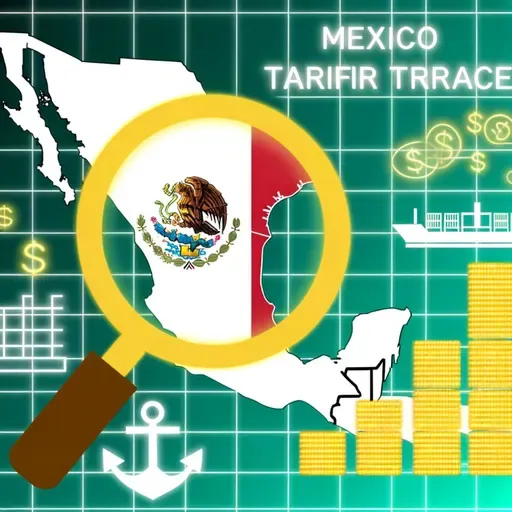
06 October 2025
Mexico Unveils Massive Tariff Hike Targeting Global Imports Amid US Trade Tensions and Economic Transformation Efforts
Mexico Tariff News and Tracker
About
Listeners, welcome to Mexico Tariff News and Tracker. Today’s episode comes at a busy moment for Mexico’s trade and tariff landscape, with the spotlight on big policy moves, industry impacts, and a flurry of headlines involving the U.S., President Trump, and the shifting ties between neighbors and rivals.
Starting with tariffs, Mexico is on the verge of enacting sweeping new tariffs across 1,400 product categories, targeting especially cars, auto parts, plastics, steel, appliances, toys, textiles, furniture, aluminum, glass, and more. The average national tariff rate now sits at 16 percent, but if the proposed legislation passes, that will jump to 34 percent. For some key products, like imported cars and auto parts—often from China or the United States—the new tariff rates could soar to as high as 50 percent. Mexican President Claudia Sheinbaum insists this is a national move to protect local manufacturers and not a coordinated effort with Washington. Nonetheless, it has already shaken up supply chains, with Chinese companies scaling back investments, and American carmakers like GM facing serious challenges selling their China-made vehicles in Mexico, given the higher costs compared to efficient Chinese competitors.
Despite the turbulence, Mexico’s leadership is painting an optimistic future. Speaking at Mexico City’s Zócalo, President Sheinbaum said she is confident about clinching a favorable trade deal with the United States and helping Mexico accelerate its own technological development. Sheinbaum’s government has secured a 90-day truce on new U.S. tariffs earlier this year, giving both sides breathing room as the landmark United States-Mexico-Canada Agreement, or USMCA, heads for review in the coming year. Sheinbaum is betting on homegrown projects around electric vehicles, semiconductors, satellites, drones, and artificial intelligence, hoping to give Mexico more control over its economic destiny while reducing dependence on imports.
On the U.S. front, Donald Trump has fired up the debate again by proposing 30 percent tariffs on imports from Mexico and the European Union as part of a broader push to support American manufacturing. But even amid these headline-grabbing figures, the real impact is more complex. According to the Budget Lab at Yale and the Tax Foundation, the weighted average applied U.S. tariff on imports is now around 17 to 19 percent, with the effective average rate, due to exemptions and trade diversions, closer to 10.5 percent as of August. Realized rates for Mexican products entering the U.S. remain lower—below 5 percent—thanks largely to the USMCA.
In short, Mexico is moving aggressively to retool its trade defenses and boost local production, while external pressure, especially from Trump’s proposals and U.S. policy uncertainty, keeps the cross-border tariff dynamic unpredictable. For now, the duel over tariff rates, national priorities, and economic security is far from settled.
Thank you for tuning in, and don’t forget to subscribe so you never miss the latest updates. This has been a quiet please production, for more check out quiet please dot ai.
For more check out https://www.quietperiodplease.com/
Avoid ths tariff fee's and check out these deals https://amzn.to/4iaM94Q
This content was created in partnership and with the help of Artificial Intelligence AI
Starting with tariffs, Mexico is on the verge of enacting sweeping new tariffs across 1,400 product categories, targeting especially cars, auto parts, plastics, steel, appliances, toys, textiles, furniture, aluminum, glass, and more. The average national tariff rate now sits at 16 percent, but if the proposed legislation passes, that will jump to 34 percent. For some key products, like imported cars and auto parts—often from China or the United States—the new tariff rates could soar to as high as 50 percent. Mexican President Claudia Sheinbaum insists this is a national move to protect local manufacturers and not a coordinated effort with Washington. Nonetheless, it has already shaken up supply chains, with Chinese companies scaling back investments, and American carmakers like GM facing serious challenges selling their China-made vehicles in Mexico, given the higher costs compared to efficient Chinese competitors.
Despite the turbulence, Mexico’s leadership is painting an optimistic future. Speaking at Mexico City’s Zócalo, President Sheinbaum said she is confident about clinching a favorable trade deal with the United States and helping Mexico accelerate its own technological development. Sheinbaum’s government has secured a 90-day truce on new U.S. tariffs earlier this year, giving both sides breathing room as the landmark United States-Mexico-Canada Agreement, or USMCA, heads for review in the coming year. Sheinbaum is betting on homegrown projects around electric vehicles, semiconductors, satellites, drones, and artificial intelligence, hoping to give Mexico more control over its economic destiny while reducing dependence on imports.
On the U.S. front, Donald Trump has fired up the debate again by proposing 30 percent tariffs on imports from Mexico and the European Union as part of a broader push to support American manufacturing. But even amid these headline-grabbing figures, the real impact is more complex. According to the Budget Lab at Yale and the Tax Foundation, the weighted average applied U.S. tariff on imports is now around 17 to 19 percent, with the effective average rate, due to exemptions and trade diversions, closer to 10.5 percent as of August. Realized rates for Mexican products entering the U.S. remain lower—below 5 percent—thanks largely to the USMCA.
In short, Mexico is moving aggressively to retool its trade defenses and boost local production, while external pressure, especially from Trump’s proposals and U.S. policy uncertainty, keeps the cross-border tariff dynamic unpredictable. For now, the duel over tariff rates, national priorities, and economic security is far from settled.
Thank you for tuning in, and don’t forget to subscribe so you never miss the latest updates. This has been a quiet please production, for more check out quiet please dot ai.
For more check out https://www.quietperiodplease.com/
Avoid ths tariff fee's and check out these deals https://amzn.to/4iaM94Q
This content was created in partnership and with the help of Artificial Intelligence AI